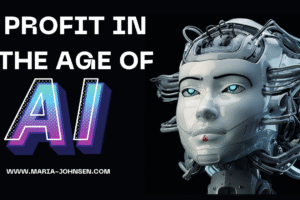Chasing Profit in the Age of AI

Profit in The Age of AI? How entrepreneurs, coders, and creators are cashing in on the machine revolution reshaping work and wealth. In a downtown Manhattan loft with glass walls and espresso machines that hiss like serpents, a 24-year-old founder in Allbirds sneakers leans back in his ergonomic chair. “It’s not just about building the model,” he says, “it’s about knowing how to sell the magic.” The magic, of course, is artificial intelligence.
The gold rush is on.
AI, once the province of graduate students with coffee-stained hoodies, has become Wall Street’s darling and Silicon Valley’s newest gospel. It’s no longer just about research papers and obscure algorithms. Now, it’s about product. Monetization. Building something people will pay for or better, building something that replaces people altogether.
Venture capital has responded accordingly. A single tweet announcing an “AI productivity tool” can still spark a feeding frenzy. The formula is almost too simple. Take an everyday human activity writing, coding, designing logos bolt on a large language model, wrap it in slick UX, and charge a subscription. Voila: startup.
But the real money isn’t just in making tools. It’s in automation quiet, pervasive, ruthless. Across industries, AI is slipping into workflows like a ghost in the machine. In legal firms, clerks are being replaced by language models that parse contracts at hyperspeed. In media, headlines are now often penned by neural nets. In customer service, the human voice is quickly vanishing behind a synthetic mask that never sleeps and never unionizes.
There’s a certain irony here. The same technologists who warn of AI’s existential risk are often the ones selling its capabilities at scale. One founder described his AI startup as “the last job you’ll ever need” he meant it as a flex.
Still, the field has its stratifications. The elite few those building foundation models raise billions and absorb electricity by the megawatt. Then there are the app layer opportunists, the prompt whisperers and micro-SaaS dreamers who live on Twitter and launch on Product Hunt. They flip GPT wrappers like real estate.
For many, making money with AI today means not inventing but remixing using existing APIs and models, building thin layers of interface and branding on top. It’s the age of the “AI co-founder,” a term that now signals not a person but a bot.
Yet the chaos is fertile. Content creators automate production with uncanny efficiency. Niche consultants use AI to draft client reports in minutes. TikTokers push “passive income with ChatGPT” to millions of viewers. Courses and e-books proliferate, promising to turn anyone into an “AI entrepreneur” for $47.
Is it sustainable? Maybe not. Most AI tools are brittle, easily broken by edge cases. Costs rise fast, especially when scale demands compute. But this is a boom, and booms don’t care about sustainability. They care about momentum.
Behind it all is a familiar American story: of opportunity, of hustle, of making a quick dollar before the wave crashes. The machine is here. It doesn’t sleep, it doesn’t eat, and if you play your cards right it might just pay your rent.
For now.

 Pages and Images/Illustrations in book
Pages and Images/Illustrations in book